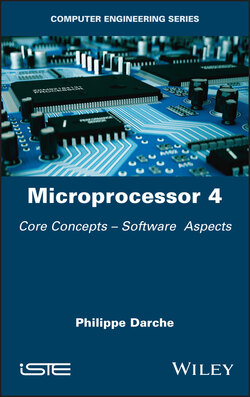Читать книгу Microprocessor 4 - Philippe Darche - Страница 20
1.2.2.2. Implicit register addressing
ОглавлениеTo simplify the programming, some instructions use one or more registers in an extended or implicit manner. In this addressing mode, also called implicit or implied addressing mode, no operand is specified after the instruction mnemonic (cf. § 2.1). Execution of the instruction involves the reference to operand that is not joined to the operating code. One synonym is implication (Brooks 1962). The instruction format is reduced by it. One example is the dex instruction from MCS6502, which decrements its index register X. The name of this appears in the mnemonic to facilitate programming. Sometimes when the accumulators are used, this mode is called “accumulator addressing”. The example below applied to MC6809. The accumulator B specified by the last letter of the mnemonic receives a value expressed in hexadecimal base.
LDB #$FA; B ← FA16
If the name of the registers does not appear in the mnemonic, then only a detailed reading of the technical documentation can specify the name of these registers. In the example below (MC6809), the instruction for multiplication mul (without operands) implicitly uses both implicit accumulator registers A and B and stores the concatenated result in these same registers, and the MSB (Most Significant Byte) is found in accumulator A, which in pseudo-code gives: A:B ← A × B.
Another example is the instruction from 8086 mul bl, which uses the implicit register A as source and destination operands in the case of multiplication in 8-bit format (ax ← bl × al for this example).
To generalize, an instruction lacking one or more operands found in a register (an accumulator for example) or in memory uses implicit addressing. We find this mode in machines with a single address called an accumulator or in the extreme case of zero-operand computers also called stack or pushdown-store machine (cf. § V1-2.7.1). By broadening the definition to registers that are not accessible to the programmer, any instruction for its execution uses the PC (Program Counter), which is therefore implicit.
